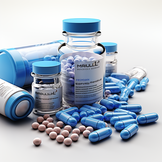Penile implants and surgery for erectile dysfunction.
- Understanding Erectile Dysfunction (ED)
- Impact on Sexual Desire and Sensation
- Overview of Penile Implants
- Description of Penile Implants
- Achieving an Erection with Inflatable and Non-inflatable Implants
- When Penile Implants are Recommended
- The Surgical Procedure of Penile Implants
- Post-surgery Considerations
- Medications and Other Treatments for ED
- Success Rate and Effectiveness of Penile Implant Surgeries
- Conclusion

Understanding Erectile Dysfunction (ED)
Erectile Dysfunction (ED) is a prevalent condition characterized by the consistent inability to achieve or maintain an erection firm enough for sexual intercourse. This can cause a significant impact on a man's self-esteem, relationships, and quality of life. Various treatments are available for ED, ranging from medications and lifestyle changes to surgical interventions like penile implants.
Impact on Sexual Desire and Sensation
ED can affect not only a man's ability to perform sexually but also his sexual desire and sensation. It can lead to a reduction in sexual desire due to anxiety or depression linked to the condition. However, it's essential to note that penile implants do not directly influence sexual desire or sensation—they merely provide a mechanical aid to achieve an erection.
Overview of Penile Implants
Penile implants are prosthetic devices surgically inserted into the penis to enable men with ED to achieve an erection.
There are two main types of implants: inflatable penile implants and non-inflatable penile implants.
Each type has unique characteristics and advantages, which we'll explore in the sections below.
Description of Penile Implants
Inflatable Penile Implants: These implants consist of inflatable cylinders placed in the penis, a pump placed in the scrotum, and a fluid-filled reservoir placed in the abdomen. When the pump is squeezed, the fluid from the reservoir fills the cylinders, causing an erection.
Non-Inflatable Penile Implants: Also known as semi-rigid or malleable implants, these consist of solid silicone rods that are inserted into the penis. The rods can be manually adjusted to achieve an erection and positioned downward when not in use.
Achieving an Erection with Inflatable and Non-inflatable Implants
With inflatable penile implants, an erection is achieved by squeezing the pump located in the scrotum. The saline solution is then transferred from the reservoir to the cylinders in the penis, resulting in an erection. After sexual activity, the fluid can be transferred back to the reservoir by pressing a deflation valve, returning the penis to a flaccid state.
In contrast, with non-inflatable implants, the silicone rods are bent into a position that mimics an erection. When not needed, they can be bent downward to conceal them.
When Penile Implants are Recommended
Penile implants are usually recommended when other treatments for ED, such as medications, lifestyle changes, or devices like vacuum constriction devices (penis pumps), have not been successful or are contraindicated due to certain health conditions. The decision is generally a personal one, taken after careful discussion with a healthcare provider.
The Surgical Procedure of Penile Implants
Penile implant surgery is a procedure that typically takes 1-2 hours and requires either general or spinal anesthesia. The exact procedure varies depending on whether an inflatable or non-inflatable implant is being inserted.
With inflatable implants, an incision is made in the lower abdomen or penile shaft, and the inflatable cylinders, pump, and saline reservoir are implanted. Once the surgery is complete, the incision is closed with sutures.
Non-inflatable implants involve an incision either in the penis or the lower abdomen, through which the silicone rods are inserted into the penis. Once the rods are in place, the incision is closed.
Post-surgery Considerations
Recovery time after penile implant surgery varies, but patients can typically resume regular activities within a few weeks. As with any surgery, there are risks, including infection, implant malfunction, and pain. However, these complications are relatively rare, and most men report satisfaction with the results.
Penile implants do not affect the size of the penis post-surgery or the sensation during intercourse. The duration of the erection can be controlled and maintained as long as desired with both types of implants, which cannot be achieved with medications or other treatments.
Medications and Other Treatments for ED
Medications such as sildenafil (Viagra), tadalafil (Cialis), and vardenafil (Levitra) are often the first line of treatment for ED. These medications work by enhancing the effects of nitric oxide, a natural chemical your body produces that relaxes muscles in the penis, increasing blood flow.
For those who cannot take or do not respond to these medications, a penis pump, also known as a vacuum constriction device, can be an effective alternative. This device creates a vacuum that pulls blood into the penis, leading to an erection.
Success Rate and Effectiveness of Penile Implant Surgeries
Penile implant surgery is considered a highly effective treatment for ED. Studies have shown that 90-95% of men are satisfied with the results of their implant surgery. The implants provide a reliable means of regaining sexual function and have a low mechanical failure rate.
Conclusion
Penile implants provide a viable solution for men with ED who haven't responded to other treatments. Both inflatable and non-inflatable implants have high success rates, can be concealed, and provide satisfactory sexual activity. Despite the inherent risks of surgery, many men find that penile implants greatly improve their quality of life and sexual confidence. As with any medical procedure, it's important to discuss the options thoroughly with your healthcare provider to make an informed decision.



